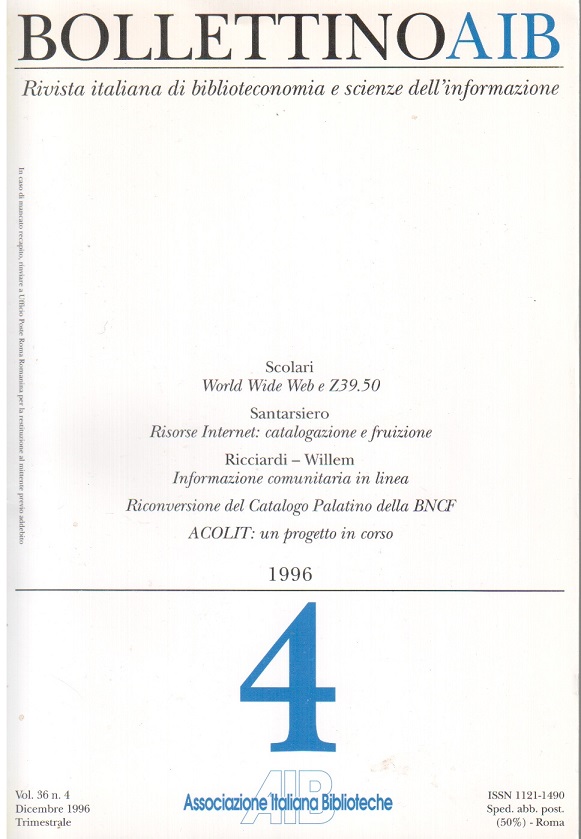World Wide Web e Z39.50: standard per la ricerca a confronto
Contenuto principale dell'articolo
Abstract
World Wide Web and Z39.50 are the two most popular standards for information retrieval; they have some common elements, but also a number of important differences.
The Web was developed at CERN of Geneva as a hypertext navigation tool for the network. During the last two years the WWW approach has been extended also to bibliographic searching and nowadays most library automation systems offer, in addition to the traditional methods of access, a WWW option.
The idea of the SR protocol, on the contrary, arose in the Seventies. Following the spread of large bibliographical databases, often under the form of union catalogues, it became obvious that users needed to access different databases through a single information retrieval language. The most ambitious project was the Linked Systems Project, funded since 1980 by the government of the United States. In the same year the BIBNETT project was launched in Norway, with six participating institutions. The development of these protocols was rather slow, because they were ahead of their time in respect of the tools offered by telecommunication systems. However we have to emphasize the interest in the process of standardization and in the spirit of OSI that was generated by these first steps among the more advanced librarians. This work produced two standards. ISO published in 1991 the SR standard divided in two documents, ISO 10162 and ISO 10163: the first defines the services of the protocol, the second the content of data structures. In the United States NISO published in 1988 the first version of the standard ANSI/NISO Z39.50. In 1992 NISO published a new edition of the standard, known as Z39.50-1992 (or Version 2), and in 1995 the third edition, known as Z39.50-1995 (or Version 3). It is a notably enlarged version with a number of new services, including the first phase of the ILL service, the request. This rapid evolution shows the vitality of this standard, which is also becoming an Internet standard.
Both standards, Z39.50 and Web, are search methods specifically designed for the end user, and dispense with the need for a specialist such as the librarian or the documentalist. Both are based on a client-server architecture. But the protocol on which Web is based is stateless. In fact a search via Web is unique, since there is no dialogue between the client and the server, but everything happens within the frame of a single request submitted to the server to which the server answers with a single answer. Z39.50 on the contrary is based on the notion of search session, supported by many information systems, and allows a dialogue between client and server. However the search via Web, taking full advantage of the hypertext model, allows a navigation virtually unlimited within the bibliographic records, whose elements become the starting points for the navigation. This utility is not typically offered in the classic online environment, such as that behind Z39.50, which uses the Boolean logic instead. Summing up, we are talking of two different ways of looking at a bibliographic search, both of which can suit different needs and whose value is largely dependent on the structure of the database and the type of data.
The main difference between Web and Z39.50 lies in the homogeneity of the search in different databases. The Web client does not know anything about the databases it is about to search; access similarities are only apparent and are an "optical illusion" generated by the graphic client you are using; furthermore each Web interface has its own features and is different from other Web interfaces. On the contrary the purpose of Z39.50 is to offer a common interface between different information systems. The Z39.50 client is able to gain "knowledge" of the remote databases and therefore is able to attain a substantial unification of methods of access to different information resources. The procedure of the query, the definition of the query structure and the record formats are the core of Z39.50 and allow this knowledge of the Z39.50 client.
Is an integration of these two technologies possible? There are a number of Web gateways to Z39.50, but this doesn't seem a true integration. More interesting is the implementation of Z39.50 clients which operate in conjunction with a Web client and take advantage of its graphical capabilities for Z39.50 searches.
Paper presented to the 5th Workshop "Electronic information in libraries and documentation centres '96" (Milan, Università cattolica del Sacro Cuore, 25-26 September 1996).Dettagli dell'articolo

Questo lavoro è fornito con la licenza Creative Commons Attribuzione - Condividi allo stesso modo 4.0.
